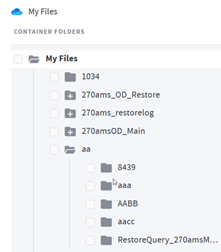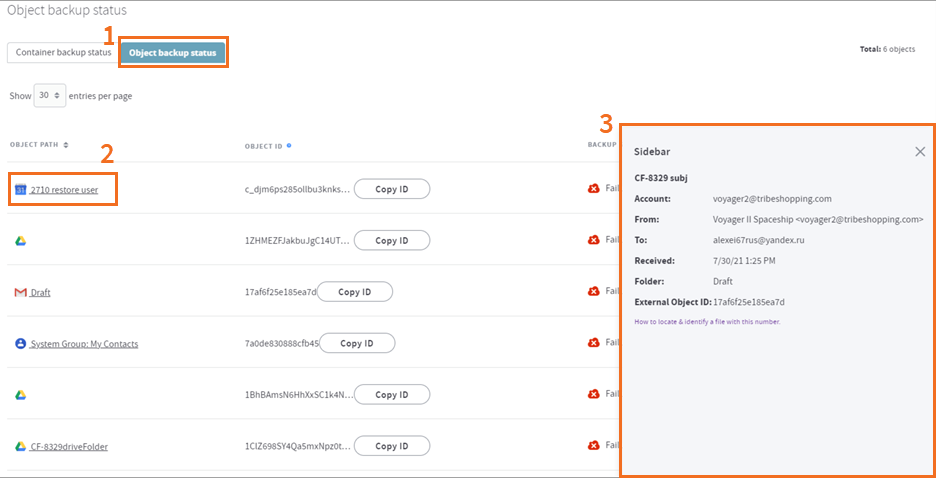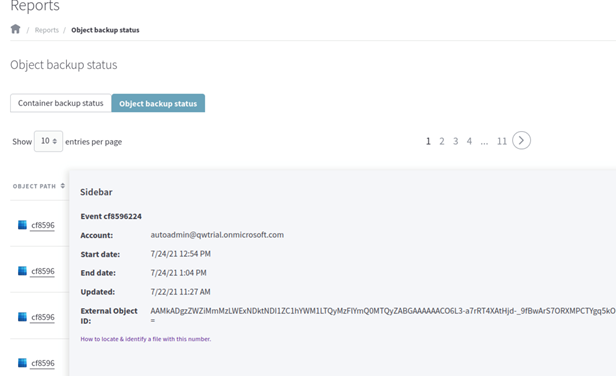Version |
2.72.0 |
When |
North America - August 4, 2021 |
Goals |
|
Improvements
Default sorting for folders in the OneDrive Browser.
Previously, folders in the Container Folders browser section were shown in random order. In version 2.72.0, we sorted the folders alphabetically, making it easier and more convenient to locate a folder in the tree.

In the European datacenter the OneDrive browser features currently have limited availability and will be rolled out to all users in future releases. To enable OneDrive browser features for your European x360Cloud organizations, please contact support.
Object sidebar with problematic object details
In x360Cloud version 2.62.0, we added an Object backup status tab to the Reports page. (For more information, see Object backup status report - x360Cloud)
In x360Cloud version 2.72.0, we are adding the ability to explore more details of a problematic object in the object sidebar. To view the object details sidebar, first click on the Object backup status tab on the Reports page. Then, click the Object Path link or an object icon.

The supported object details depend on object type:
- Email
- From/To – sender and recipient email addresses
- Received – date & time email was received
- Folder – folder path to an email
- Event
- Start/End date – event start time
- Updated – date of last modification in the source system
- File
- Folder – folder path to a file
- Created – date of file creation
- Updated – date of last modification in the source system
- Contact
- Name – name and surname of a contact
- Email – contact’s email
- Created – date of contact creation
- Updated – date of last modification in the source system
- Common for all object types
- Account – identifier of a protected container that the object belongs to. It can be the email address of a user account, SharePoint site URL, or Google Workspace shared drive ID that can be used along with the External Object ID to locate an object in the source system.
- External Object ID – identifier for an object in the source system. Can be used to locate an object in the source system and verify details.
In some instances, the fields in the sidebar may remain blank, e.g., when an object path cannot be fetched from the source system. If this occurs, you can use the external object identifier to get the object details from the source system directly. (For guidelines on how to do this, see Locate an object in the source system - x360Cloud)

Currently, the object backup status features have limited availability. To enable the them for your x360Cloud organizations, please contact support .
Fixes
- Fixes for customer escalations and markup issues.
Known issues
- “Total number of licenses selected for backup” counter sometimes doesn’t reflect the factual protected user number when bulk selection/de-selection is performed on Accounts page.
- Restorations for “docx,” “xlsx,” and “pptx” files backed up for SharePoint are getting “Partial” restoration status even though these file types are successfully restored.
- Smart Search shows an incorrect number of matching results for Mail when using Filter by collection.
- Descriptions for some issues and backup progress are not shown in the container-level downloadable backup report and on the Reports page.
- Archive emails are restored in a separate (timestamped) target folder when restored with general emails.
SUPPORT | 720-204-4500 | 800-352-0248
- Contact Axcient Support at https://partner.axcient.com/login or call 800-352-0248
- Free certification courses are available in the Axcient x360Portal under Training
- To learn more about any of our Axcient products, sign up for a free one-on-one training
- Subscribe to the Axcient Status page for a list of status updates and scheduled maintenance
879